|
|
Post by Lukas MG (chenessfan) on Oct 29, 2023 11:27:33 GMT
I carry a CZ P10c when I'm hunting. Also found it much more ergonomic than the Glock 19. I kinda regret not having bough the optics ready version but honestly iron sights work just fine for my applications (coup the grace on downed animals if the rifle cannot be brought to bear which is very rarely necessary in the first place). I have replaced the rear sight with an adjustable sight because I do occasionally take the gun to a 25m range for training and the standard sight wasn't ideal for that. Not that it's a match gun but it shoots quite well.
|
|
|
|
Post by Lukas MG (chenessfan) on May 8, 2022 20:13:53 GMT
Thanks guys, glad you like it!
|
|
|
|
Post by Lukas MG (chenessfan) on May 5, 2022 8:14:05 GMT
Finally a new sword to show! Here's a XVIII war sword made to the customer's specifications with green grip and wire wrap. The grip work and sheath is courtesy of 3wunder. at. This is a powerful war sword with a robust and stiff blade, suited to both the cut and the thrust against heavy targets. It can of course be used in unarmored fighting with devastating effect but it is clearly built to also withstand the rigors of connecting with harder targets. ![]() 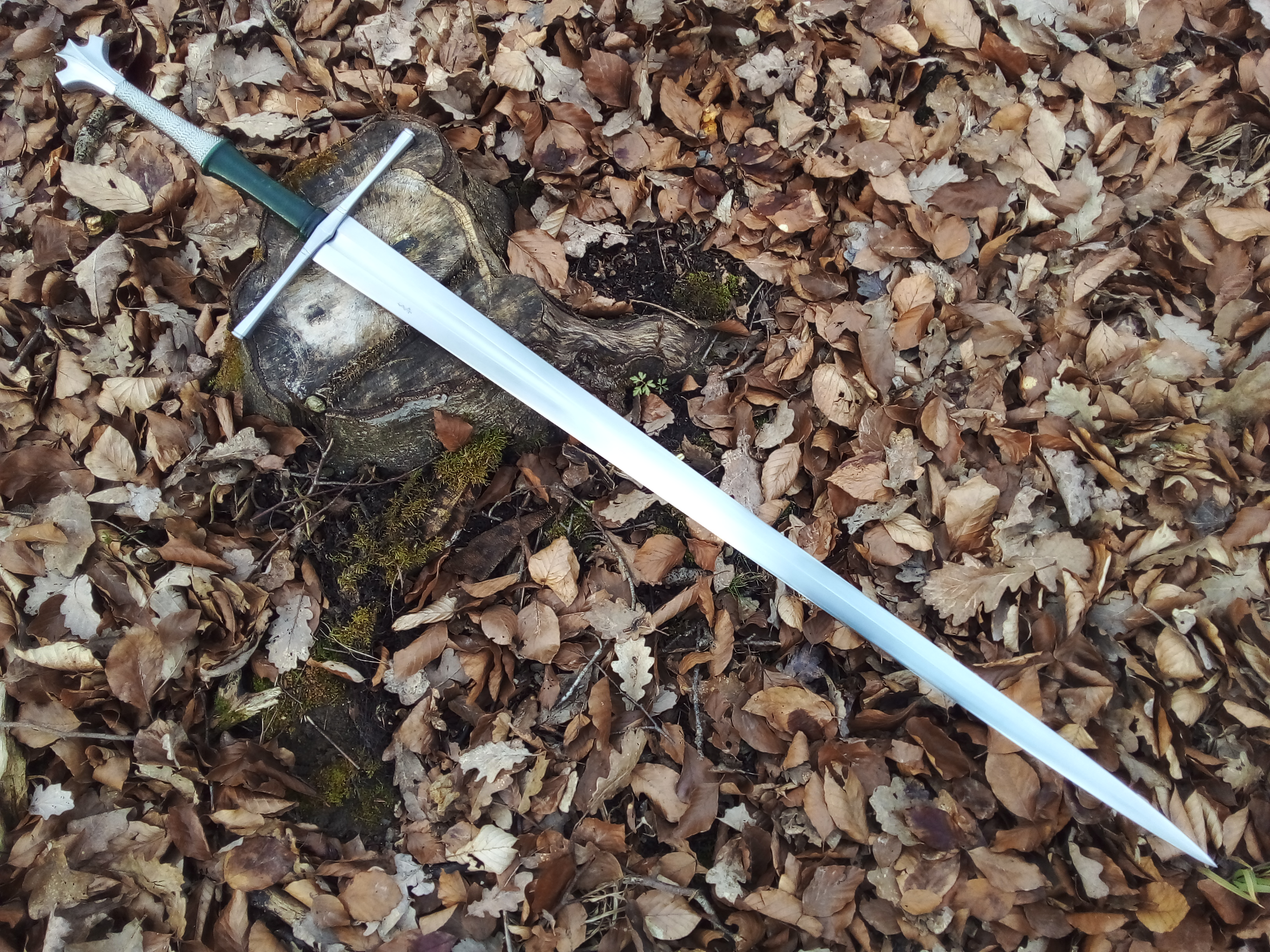 Weight: 1725g Blade length: 90cm Overall length: 122,5cm Width at base: 5cm Width at CoP 3,2cm Thickness at base: 8mm Point of Balance: 9,5cm 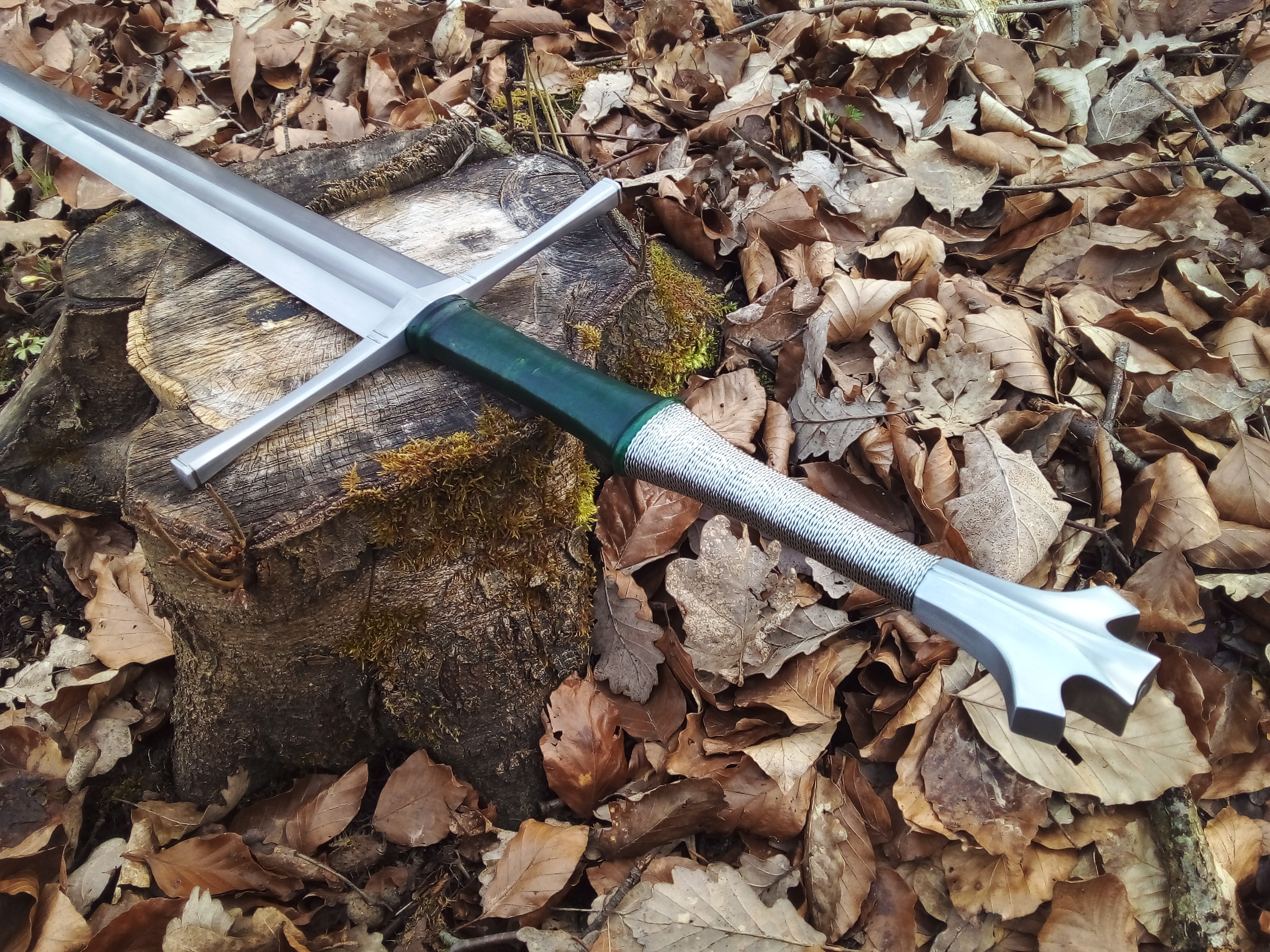 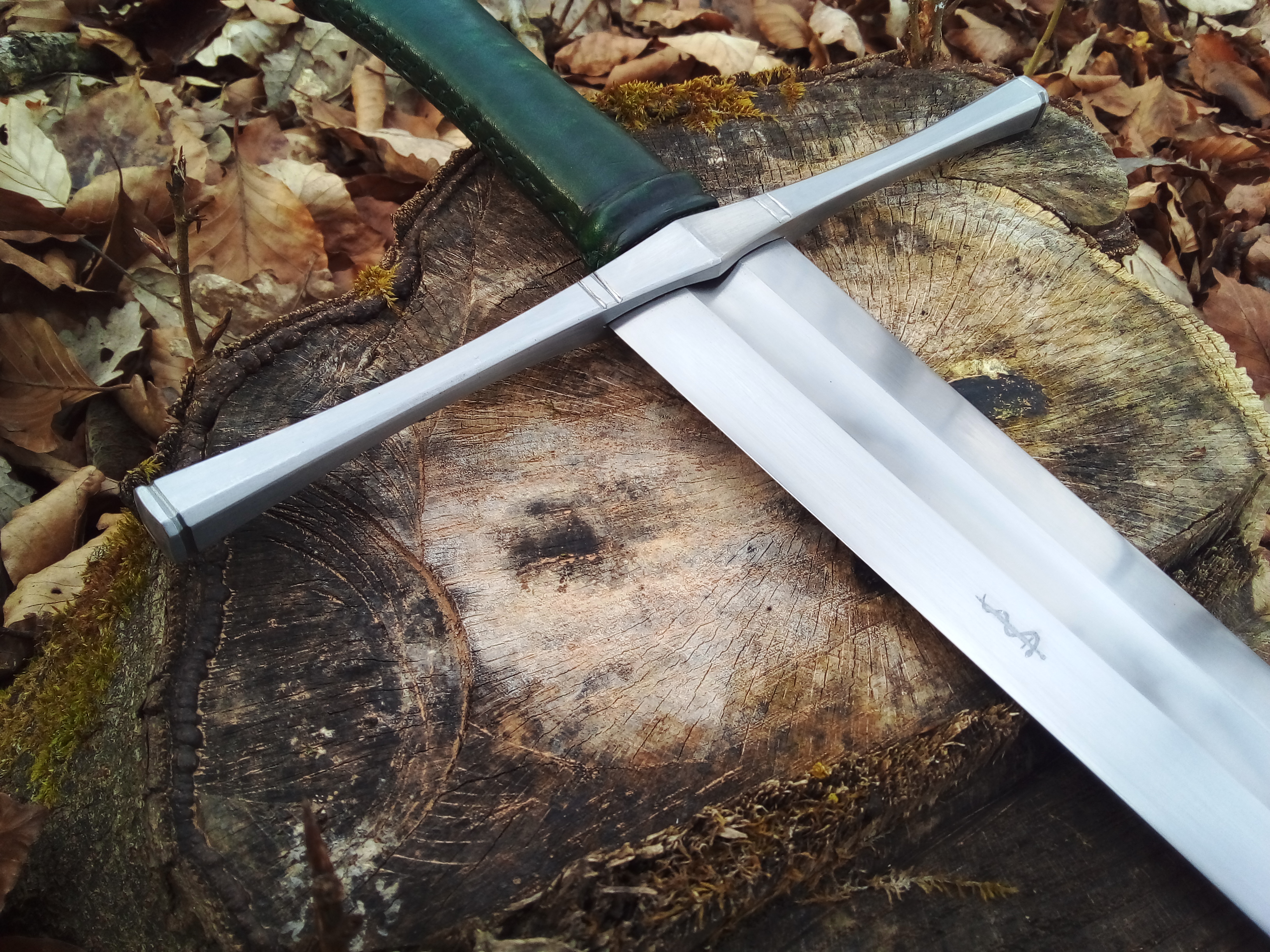 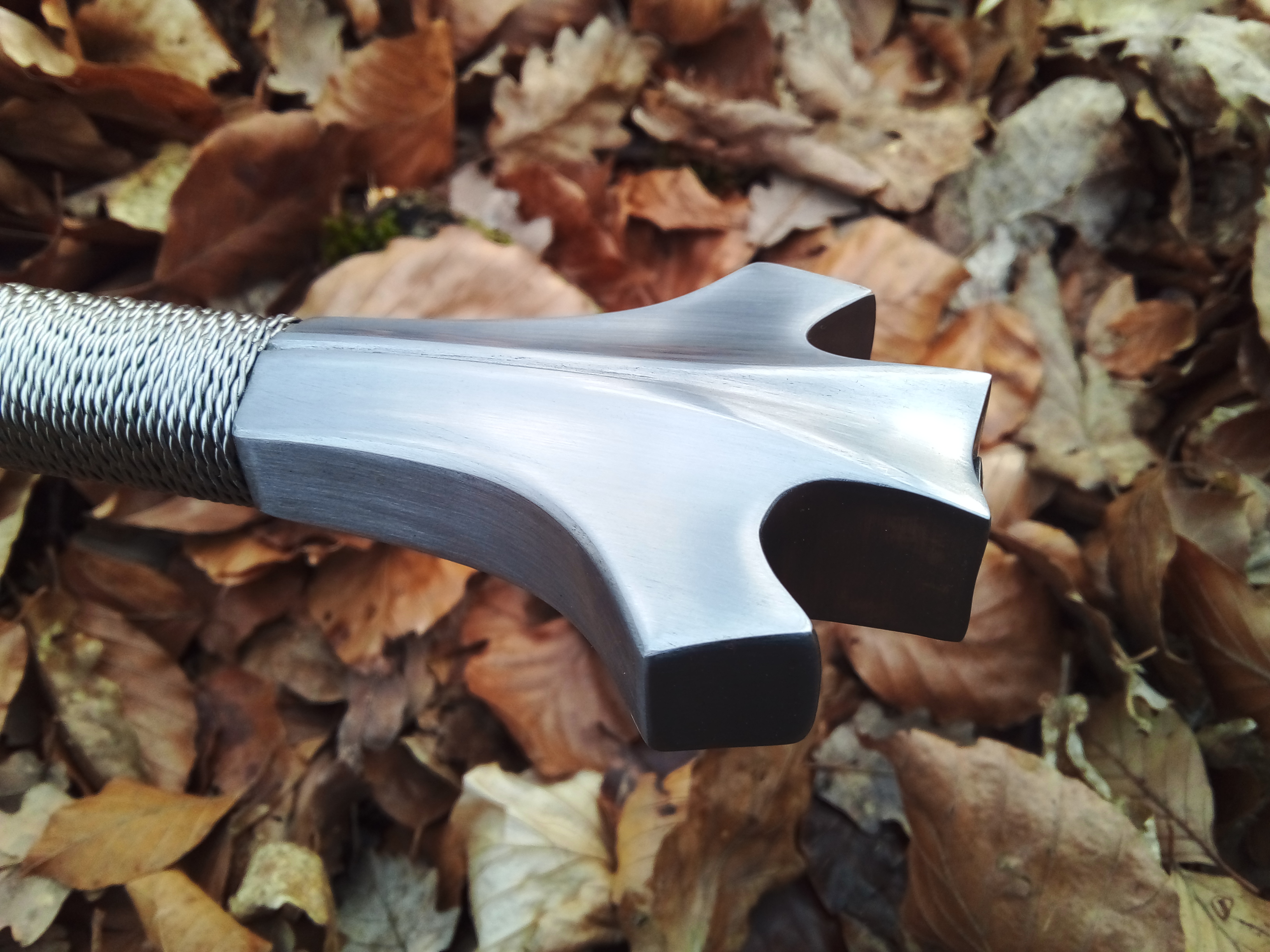 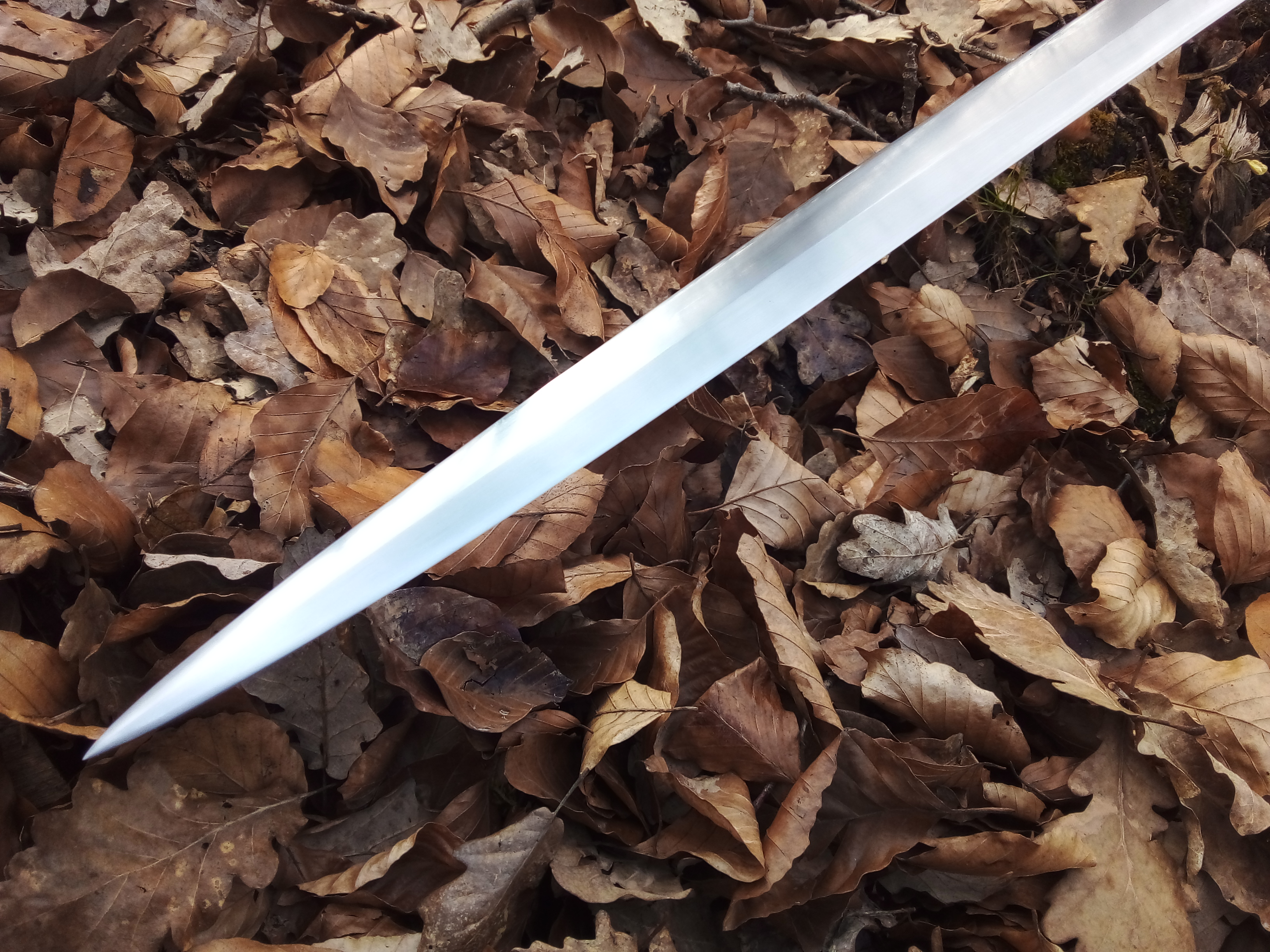 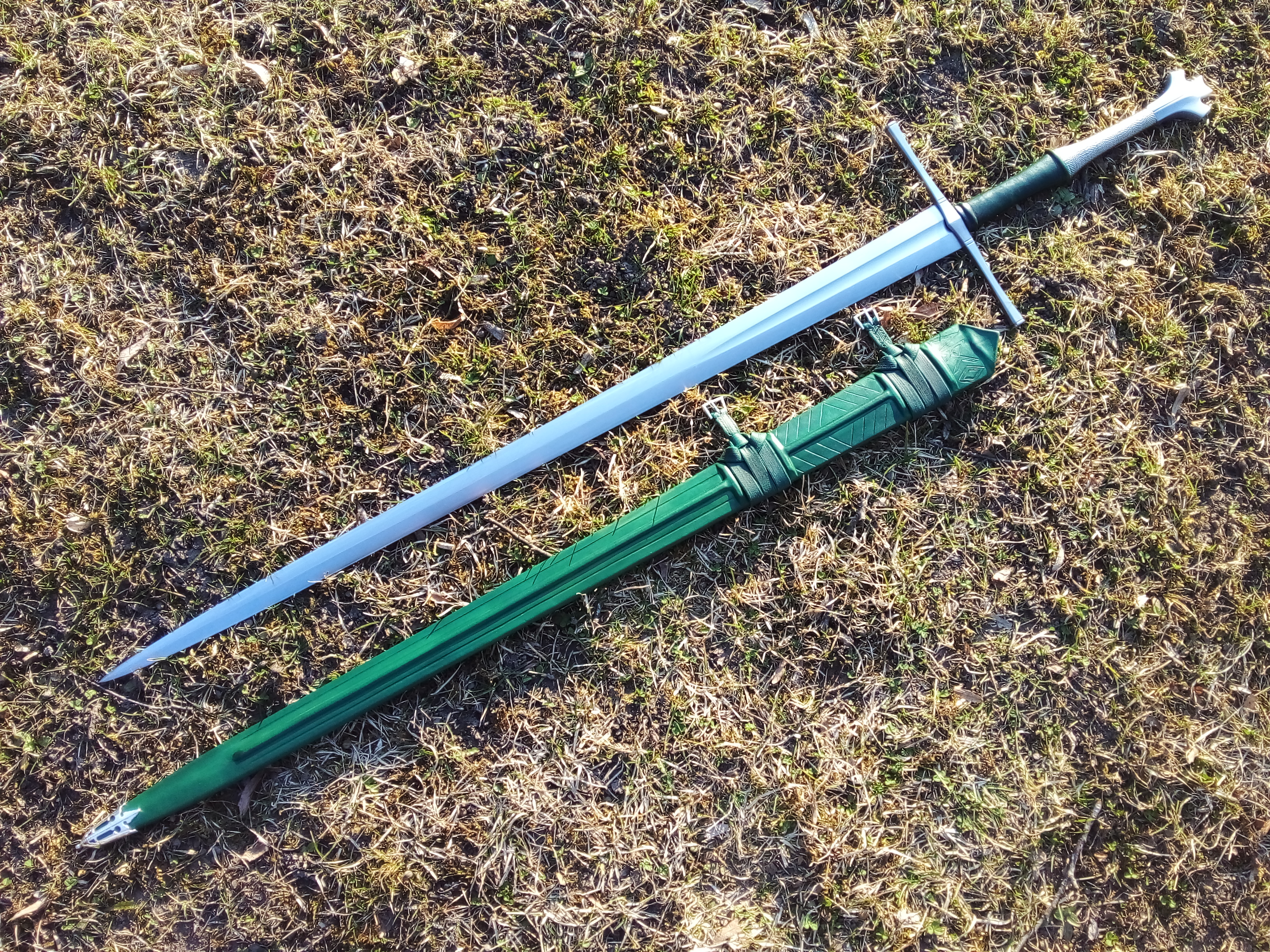  (last pic by the customer) The customer was so pleasant to write me a review to be posted. It is in German but some of you might find in interesting. Thanks for watching! Review: "Pommel: Der Pommel ist fantastisch gearbeitet. Sehr schön gleichmäßig. Die Kanten sind sauber und nicht sonderlich scharfkantig. Die Akzente sind sehr sauber verarbeitet und machen einen hochwertigen Eindruck. Und auch wenn ich den visuell sehr ansprechend finde, gebe ich dir jetzt im Nachhinein recht. Mein nächster Pommel wird kein Fishtail mehr, einfach nur um ihn besser greifen zu können. Handle: Der Griff ist hervorragend geformt. Er schmiegt sich sehr schön in die Handfläche und liegt bei Hieben gut in der Hand. Trotz des stattlichen Gewichts, macht dieser Griff es für mich sehr einfach die Klinge zu kontrollieren. Crossguard: Der Crossguard ist mein persönliches Highlight. Die Akzente, die du im Nachhinein gesetzt hast geben noch einmal dieses gewisse Etwas. Die allg. Form ist unglaublich gut geworden. Die Verjüngung und anschließend Erweiterung in die rechteckigen Endstücke sind ein Augenschmaus. Blade: Der Point-Of-Balance finde ich ist dir sehr gut gelungen. Die Schärfe ist großartig. Ich konnte mir die Haare vom Arm rasieren so scharf kam es hier an. Die Pool-Nudeln hatten keine Chance. Es ist perfekt gerade und der Distel-Taper ist der äußerst gelungen von dem was ich sehen kann. Der Fuller ist, soweit ich das beurteilen kann, perfekt zentriert. Weight: Das Gewicht ist stolz. Ich war dann doch ein wenig überrascht, sieht es auf den Bildern doch leichter aus. Das heißt nicht, dass ich damit unglücklich bin, ganz und gar nicht. Wir haben im Vorfeld ja abgesprochen, dass es eher Richtung Kriegsschwert geht als die “zivile” Variante. Dementsprechend mag ich die “Rigidness” der Klinge. Sie fühlt sich gar unverwüstlich an. General: Die Klinge macht auf mich einen extrem stabilen Eindruck. Auch nach 1-2h der Benutzung ist mir nichts negativ aufgefallen. Adis Arbeit ist ebenfalls fantastisch (ihm habe ich bereits ein Review geschrieben). Keins der Teile wackelt, der Spalt zwischen Klinge und Crossguard ist minimal und alles in Allem fühlt es sich extrem wertig an. Price: Meiner Meinung nach ist das Schwert jeden Cent wert. Ich bereue es keine Sekunde und ich bin der Meinung eine solch meisterliche Arbeit sollte auch entsprechend gewürdigt warden. Communication: Du warst binnen weniger Tage immer mit einer Antwort parat und konntest dich meiner Probleme und Bedenken und extra Wünsche annehmen. Du hast mich tatkräftig beraten und mir stets das Gefühl gegeben, dass ich mit dir die richtige Entscheidung getroffen habe. Darüber hinaus waren immer regelmäßige Updates da. Etwas, dass ich sehr zu schätzen weiß. Waiting: Soweit es mich betrifft, war das Schwert theoretisch bereits nach 6-7 Monaten fertig, statt den beanschlagten 12. Dafür ein richtig dickes Lob. Ich weiß, dass das nicht zwingend die Regel ist, aber das macht nichts. Summary: Es ist wohl das beste Schwert, dass ich jemals in den Händen gehalten habe. Eine wahre Meisterleistung von der meine Enkel noch gut haben werden (wenn ich jemals welche haben werde). Ich werde es wie meinen Augapfel hegen und pflegen auf das es mir noch lange erhalten bleibt." |
|
|
|
Post by Lukas MG (chenessfan) on Mar 19, 2022 21:42:59 GMT
Meyer isn't everything ;) Call it Zornhau, Zorhnau-Ort, Oberhau in unteres Hängen, doesn't really matter. What matters more is that you are always stepping first and then moving the hands/sword. Often seen in cutting videos because it generates power more easily but martially, it's almost always a bad idea, moving your body into the opponent's reach before your sword is protecting you/threatening your opponent.
|
|
|
|
Post by Lukas MG (chenessfan) on Dec 26, 2021 8:15:22 GMT
Yes, I thought it a pity that you went back to the States. We spend some good hours in your man's cave and I learned quite a bit. It really is an astonishing collection. I can only imagine your gun collection 😄
Merry Christmas and best wishes from Germany!
|
|
|
|
Post by Lukas MG (chenessfan) on Oct 21, 2021 17:14:05 GMT
a Rengenyei standard feder Owning both, I can say that the Regenyei standard feder doesn't handle like the Munich, it has much less blade presence and is a bit lighter. The Trnava light would be a better match. Btw, I agree with your choice. I own the Munich and have cut with the Brescia. It does cut a bit better (more easily) but the Munich cuts quite well and does everything else better than the Brescia. Stouter, better in the thrust, better point control and more powerful in the cut. |
|
|
|
Post by Lukas MG (chenessfan) on Oct 2, 2021 9:24:33 GMT
I find it no surprise that the probably lighter and certainly much thinner machete cuts a light target better than the more substantial kukri. On light targets, speed and acuteness of edge matter most and a thin blade always helps. Heavy, dense targets are a different animal, as is actual combat.
|
|
|
|
Post by Lukas MG (chenessfan) on Aug 16, 2021 7:13:17 GMT
Thanks guys, glad you like them! I did a little bit of cutting with the Dussack today, it really is a sweet little sword. Cuts and handles very well. And indeed a bit of a medieval "tactical" design ;) I'm almost considering getting a kydex sheath for it made so I could potentially strap it to my bag in case of another (zombified) pandemic :D
|
|
|
|
Post by Lukas MG (chenessfan) on Aug 14, 2021 12:07:12 GMT
That almost hurts to watch. The katana guy goes to distance with points touching (at that distance he can already hit the knife person in the hands yet he does nothing!), then lifts up to cut to the head, giving the person with the shorter weapon time to close in/deflect and counter, all of which the katana guy just lets happen). Why? Not at all what one should do. Keep away, then snap cut to the knife guy's hand. I'm sorry but this type of tactics and techniques immediately falls apart in sparring/against an uncooperative opponent.
Also, another classic example of a two-handed cut coming down and the response is a cut to the hands while in range of the cut. This magically lets the cut stop in mid-air, giving time for the knife guy to thrust at the belly. facepalm...
That being said, I like the way they move. Cleanly, crisply and smoothly. They clearly are experienced martial artists and know how to move a sword but that doesn't make their tactics/technique any sounder.
|
|
|
|
Post by Lukas MG (chenessfan) on Aug 13, 2021 21:18:12 GMT
Hi, these two pieces were recently finished. A dark XVIIIb longsword and a rustic Dussack. 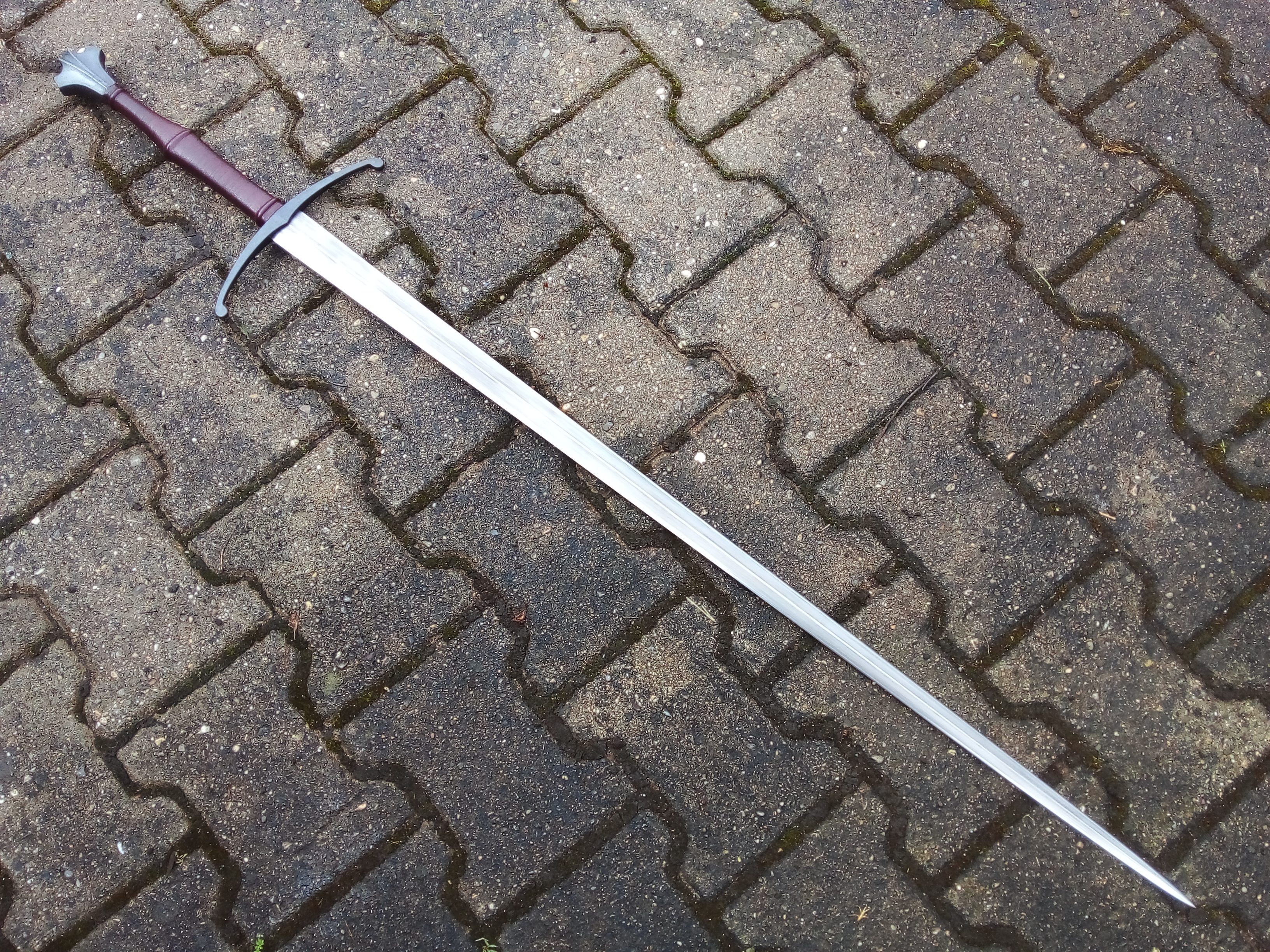 This slender XVIIIb longsword was a commission from a friend with a love for the dark and mysterious. Guard and pommel are fire-blackened, the blade is acid-etched to give a dark, distressed look. The very slender blade is clearly optimized for the thrust but remains just wide enough around the CoP to deliver an effective cut. Point control is excellent. Overall this is a very light and nimble sword that though mainly intended for two-handed use feels quite at home in one hand as well. Stats: Overall length: 119,5cm Blade length: 93cm Blade width: 3,5cm PoB: 13cm CoP: 60cm Weight: 1220g 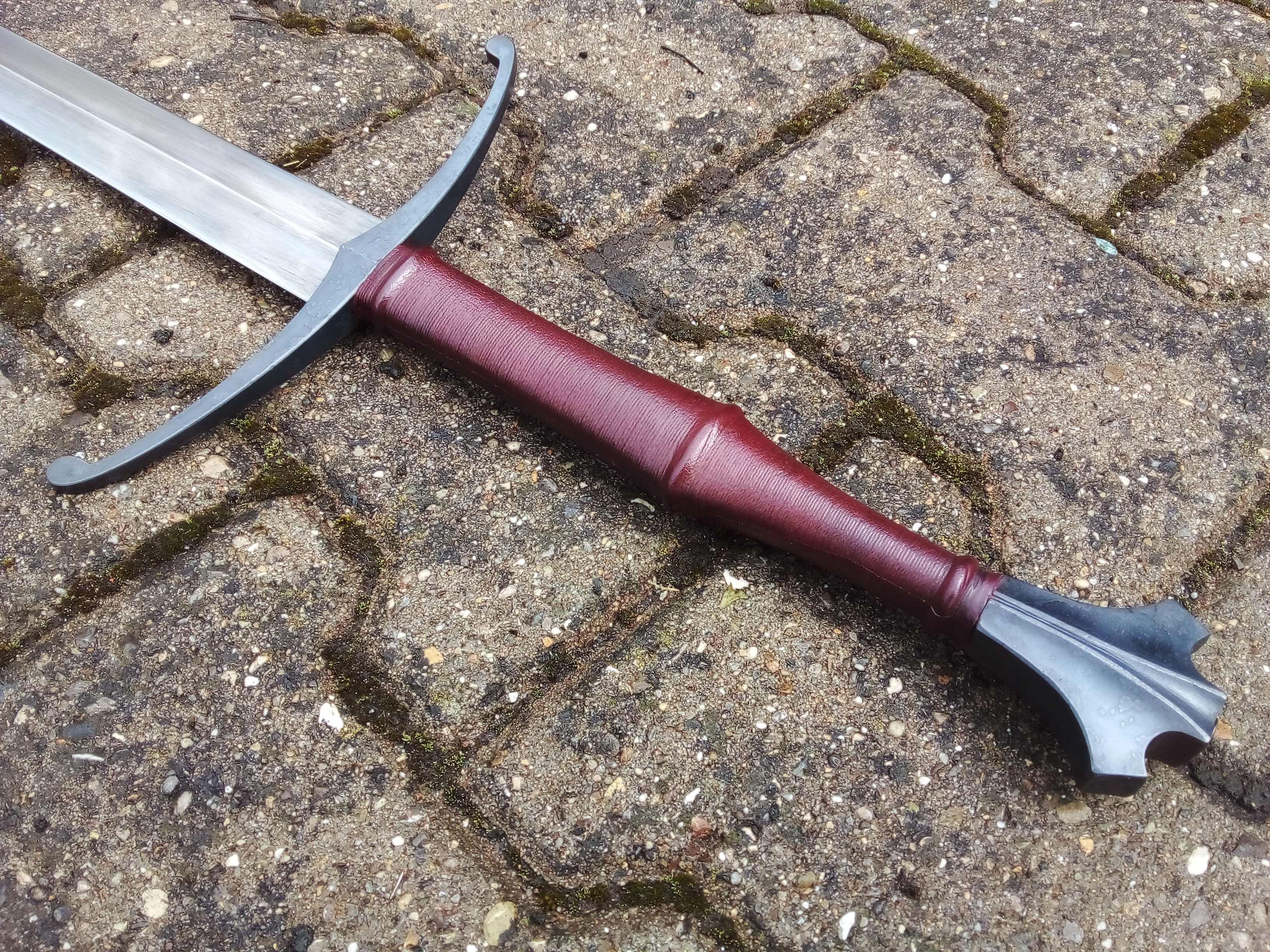 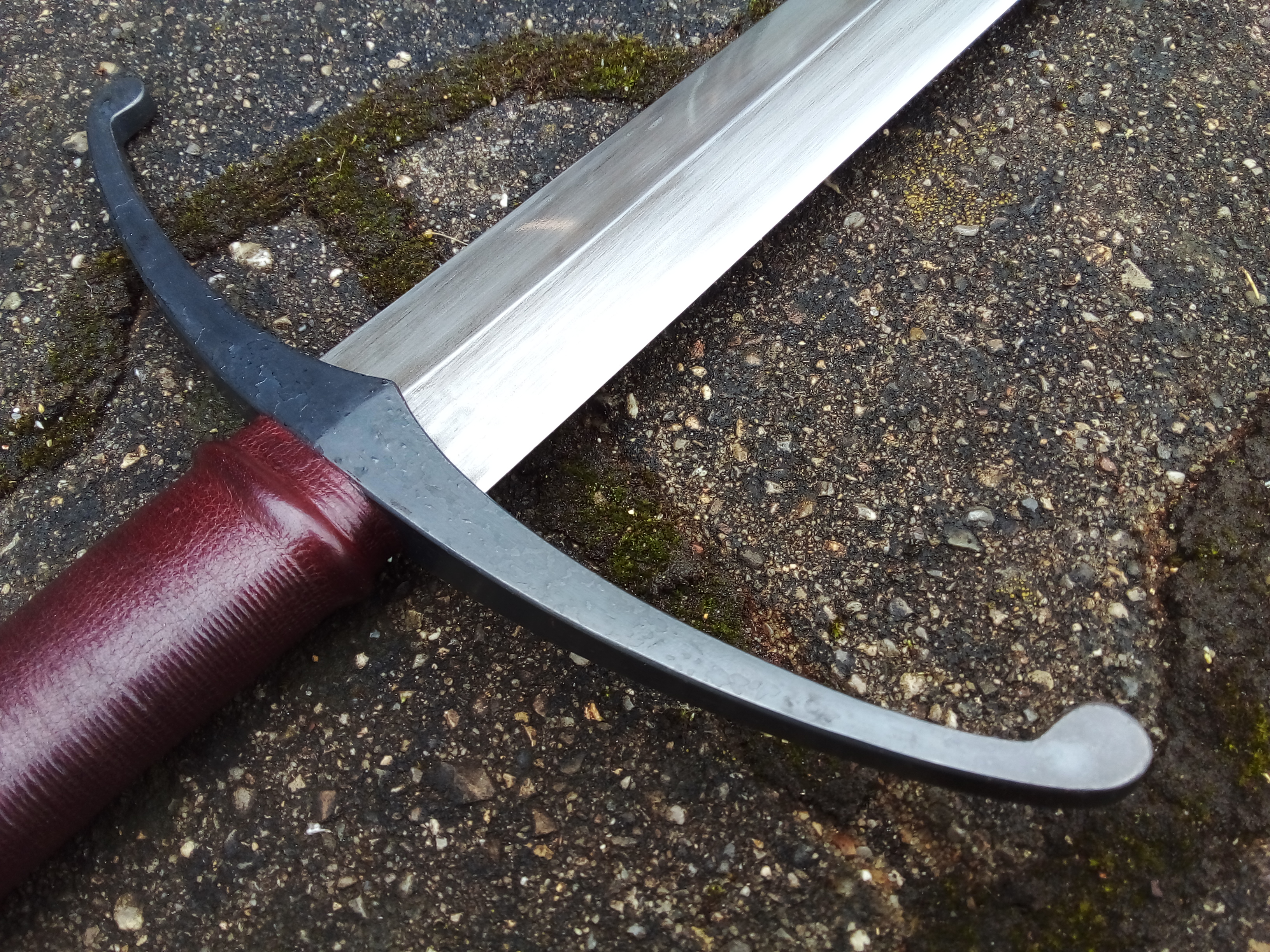 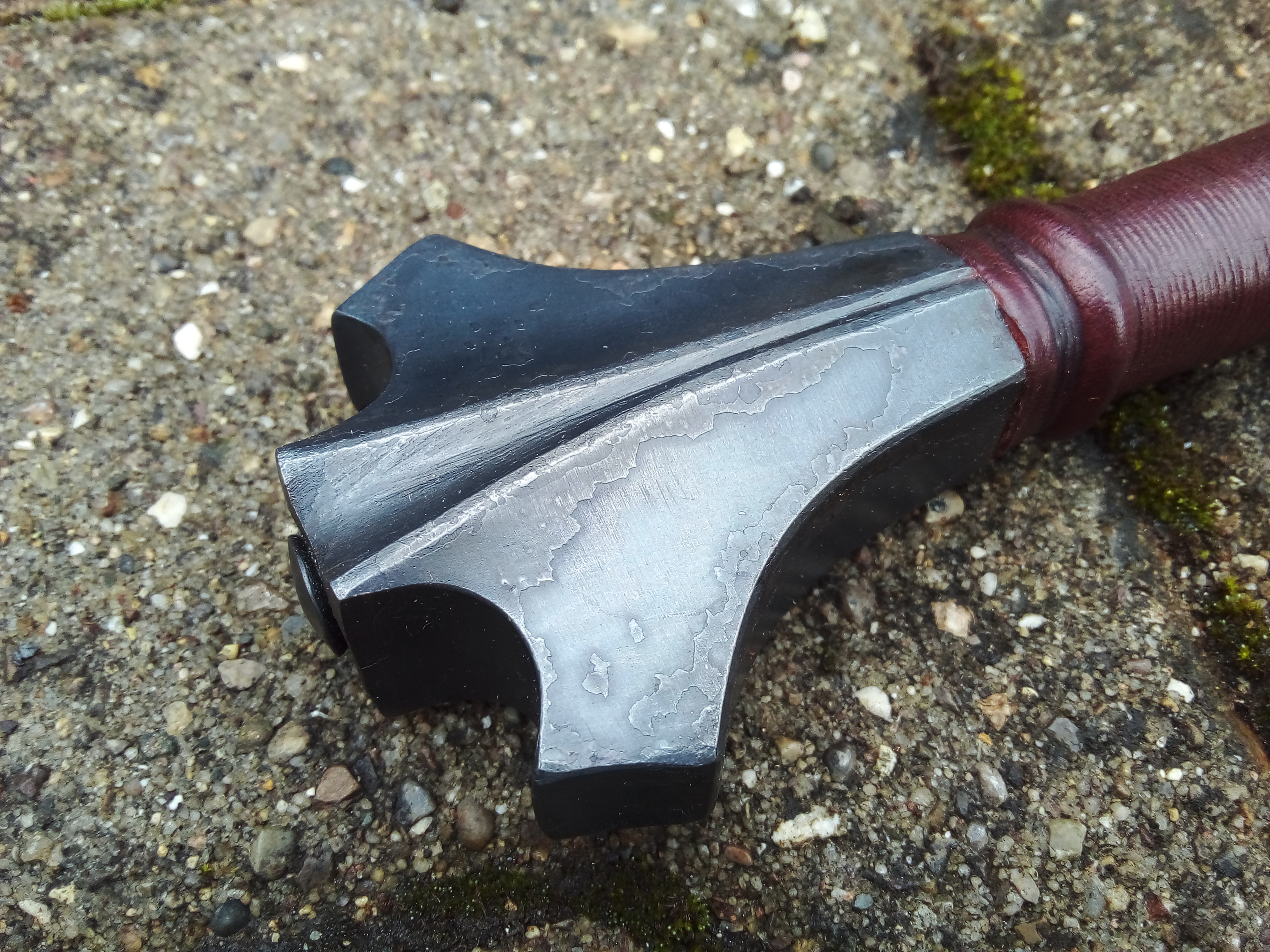 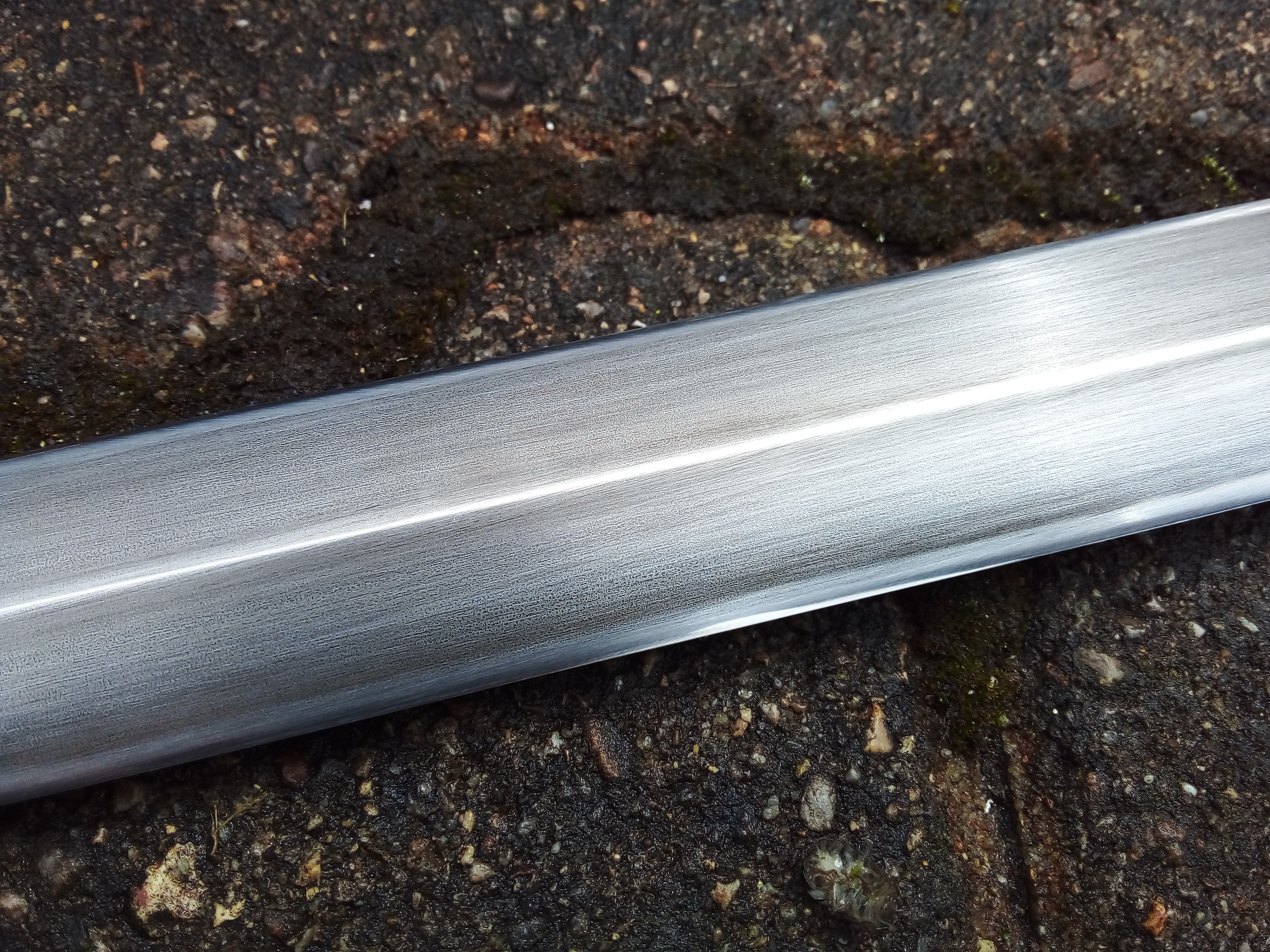 The Dussack was a very popular weapon in 16th century fencing schools and is depicted in many period manuals. The training versions were probably made of wood but there are a few surviving formerly sharp steel originals. The Dussack in this simple form is believed to be somewhat of a commoner’s weapon, fairly easy to make and an overall very practical design. It offers excellent cutting and good thrusting capabilities in a very compact, durable and handy package. Hand protection is also quite good. 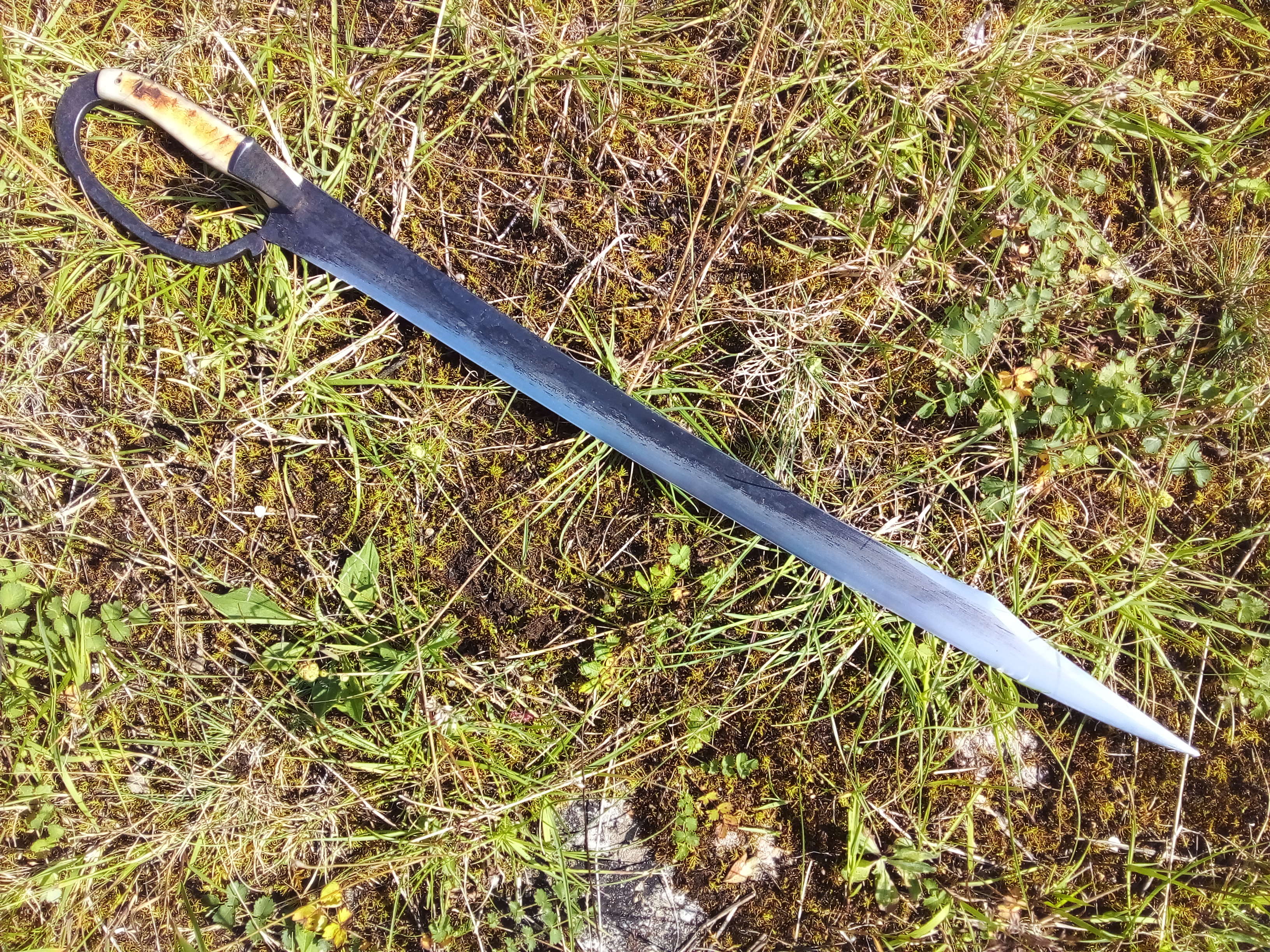 Hinting at the suspected fairly “rough and ready” character of the originals, I left the rough finish from forging and heat treatment intact where possible, with only the edges and the tip finely polished. The grip scales are made from sheep horn, quite a nice material though not always easy to work with. I am not aware of a surviving steel Dussack with a Nagel but such versions are depicted in many manuals and it just makes sense to have one from a fencing point of view. 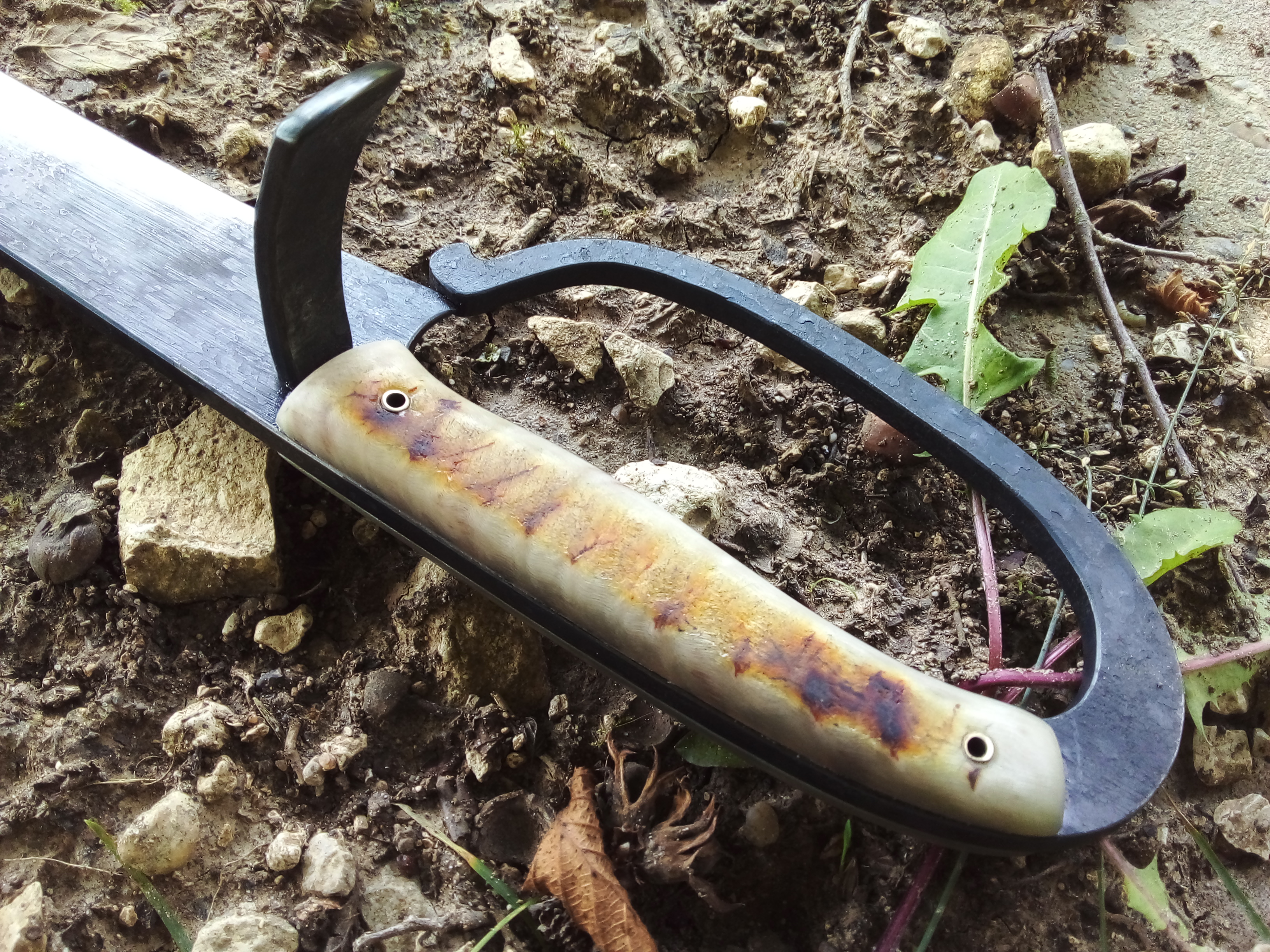 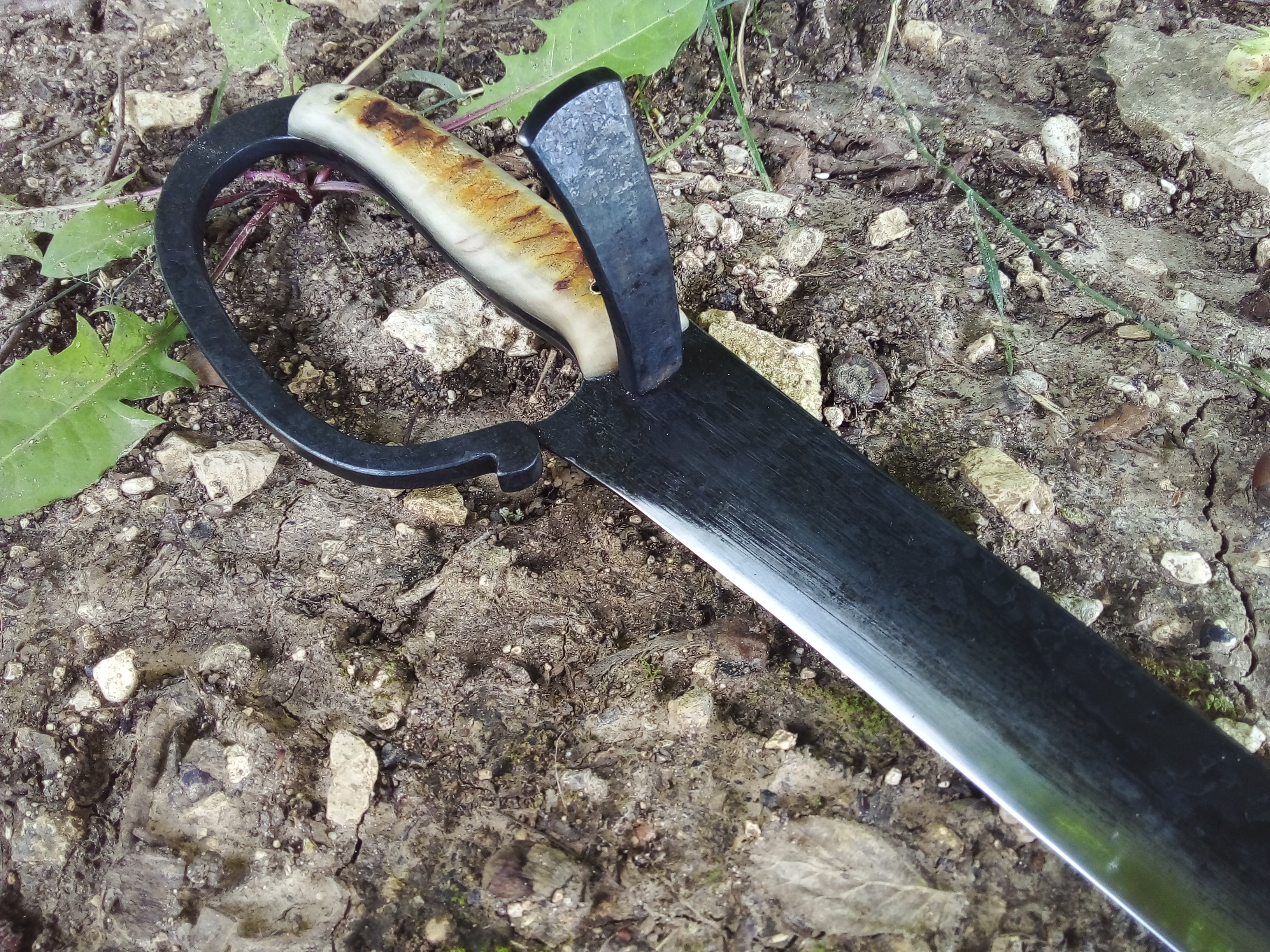 Overall, this is a very capable little weapon, stout, reliable and quick in the hand. Stats: Overall length: 67,5cm Blade length: 54cm PoB: 10cm CoP: 40cm Weight: 550g 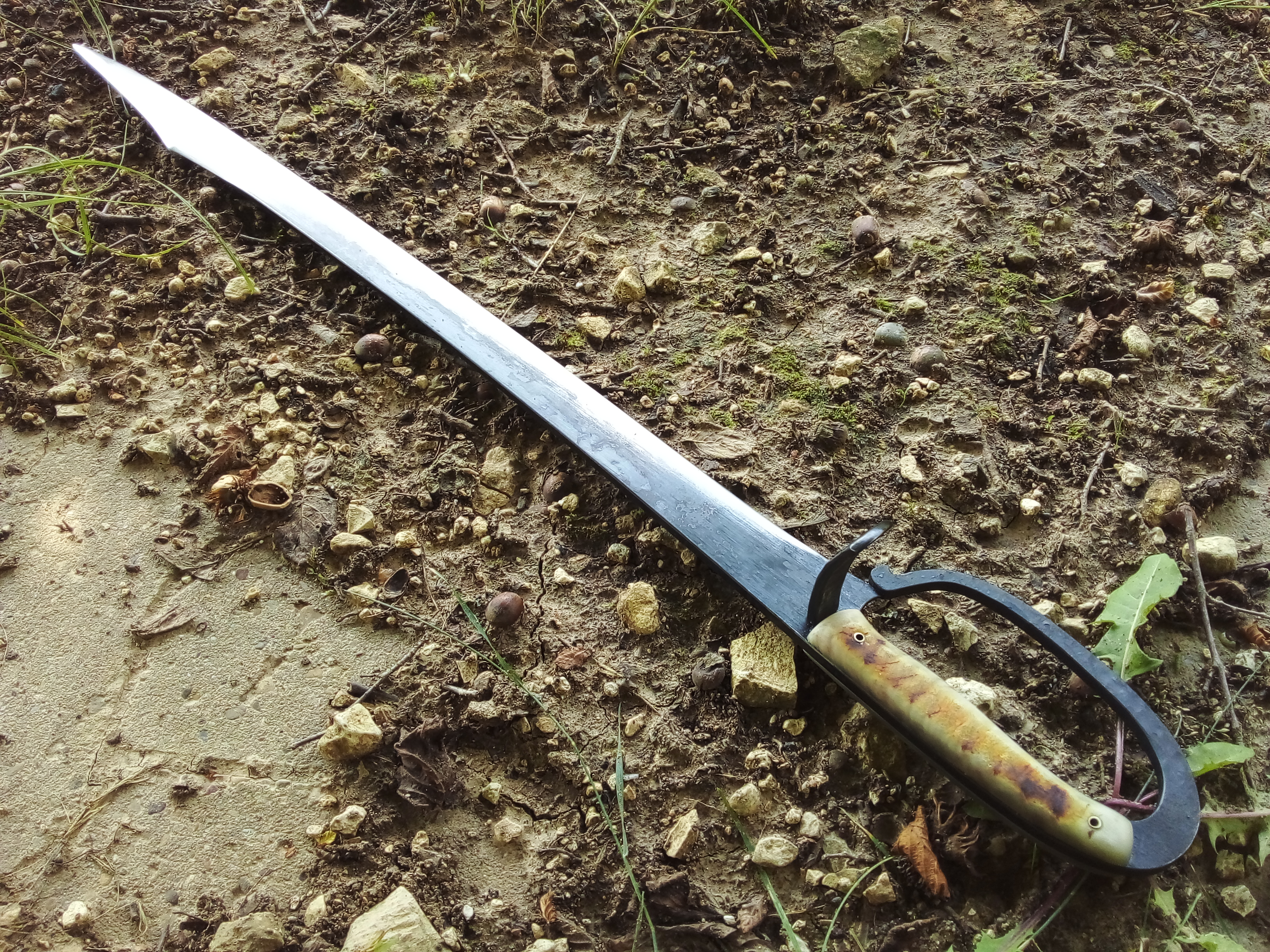 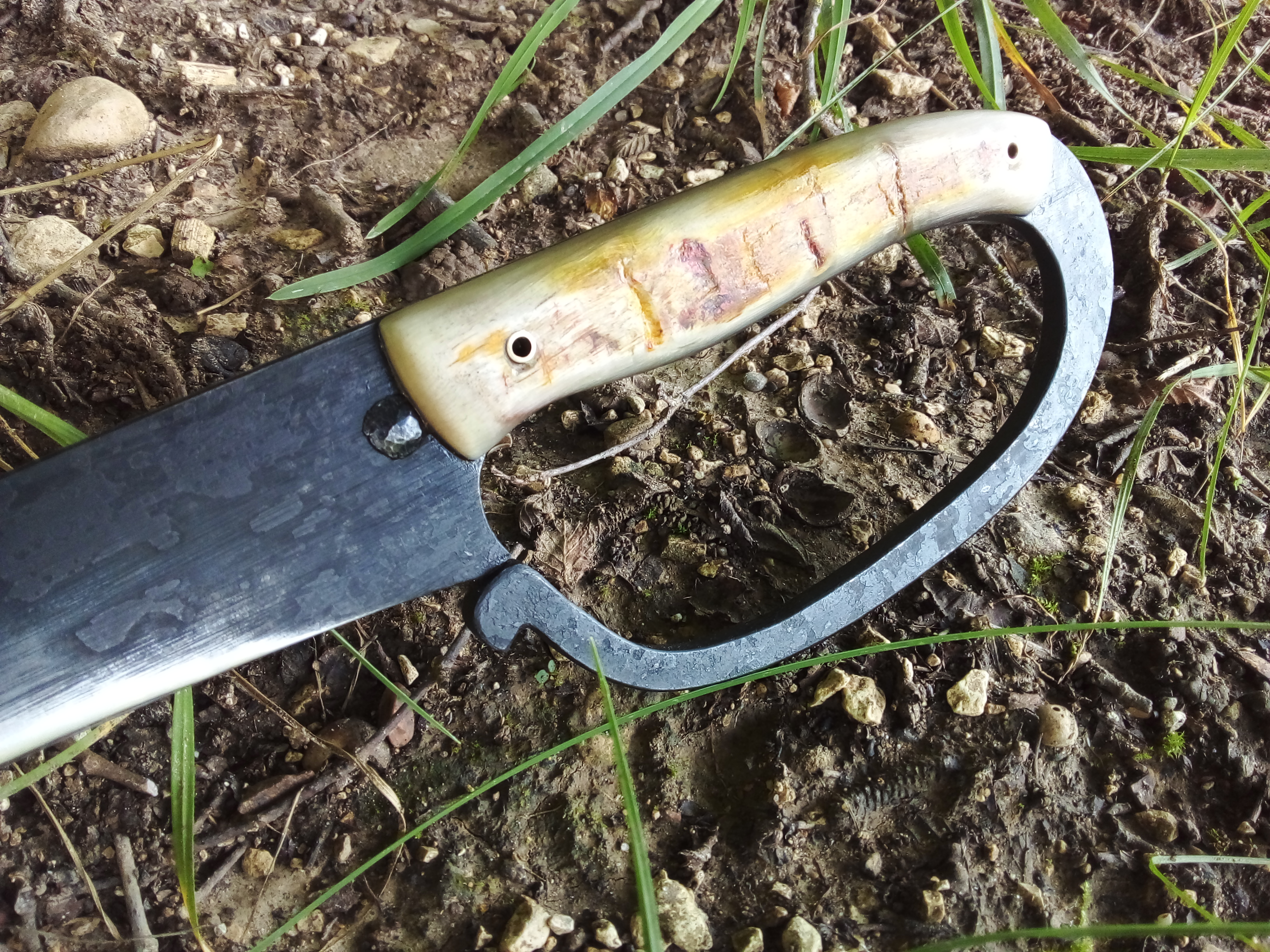 |
|
|
|
Post by Lukas MG (chenessfan) on Aug 11, 2021 16:22:20 GMT
Bit late to the party, just adding my opinion. It is based on my experience as a HEMA practitioner. I think the reach advantage of the longsword is the major factor. Unless the surroundings really favor the shorter sword (tight spaces, low ceiling, etc), 10" or more of additional blade just make a real difference. Yes, there are techniques and tactics for dealing with an opponent who has a relevant reach advantage but it remains a large disadvantage to have the shorter blade.
The false edge and longer cross guard of the longsword are nice but a competent katana wielder is used to only having one edge and a smaller round guard (which protects the sides of the hand better, too), I don't believe that will be a deciding factor.
In the end, the absolute main factor is skill. Any noticeable difference in skill level (doesn't need to be much) will be more important than weapon choice.
As an aside, possibly with both complete newbies the katana will make it easier to score an effective hit. Straight, narrow bladed longswords are more difficult to cut with. In the thrust this doesn't matter though.
|
|
|
|
Post by Lukas MG (chenessfan) on Aug 9, 2021 21:35:11 GMT
Good stuff. How sharp are the swords? In my experience, as soon as fabric comes into play, a truly sharp, highly polished edge is needed.
|
|
|
|
Post by Lukas MG (chenessfan) on May 31, 2021 21:41:14 GMT
In regards to this post, this is the e-mail response to this customer that I am sharing on this post. Hi Troy I have been giving the issue at hand a great deal of thought over the last few days and have come up with a few additional options for you to resolve your issue, but also some thoughts and insights into the product itself. Because I’m a businessman that wants to make his customers happy and have always had the motto that the customer is always right, I quickly jumped on trying to make things right with you on that post, by offering to make you another one. However after thinking about this and reading your comments on the posts, I think that we may need to go another direction with this. As you know, most of the swords we make are quite stout, and are tested destructively before a new model is released. However the testing has not to date included any flex tests as our swords are case hardened, and so while they are designed to flex to a certain degree they are not spring tempered. This means that if you try to bend the swords, like a differentially hardened Katana, they will take a set. So when I read that you want to deliberately try to bend the new sword for comparisons sake, while it may resist better than the one you received, it will still basically just destroy a new sword and leave everyone disappointed as these swords were not designed to have a spring temper. For longer swords of any kind, when they hit a target they cannot cut through cleanly the energy has to go somewhere. Best case scenario, the sword is bent and takes a set. Worst case, it shatters or snaps and comes flying off. Because our swords are intended for heavy use, if the blade fails, we prefer it bends rather than breaks and so we temper our swords accordingly. Obviously once you break one, you can never use it again (and there is a chance that if it shatters or breaks during cutting, someone could be seriously hurt or even killed). A bent sword, depending on how bad, can be straightened out and still used. That’s not to say that when a sword is bent it’s as strong as it was before. It is the same principle with bending a paperclip back and forth enough so it gets weak. To check the flexibility of a sword, I and many sword makers do NOT recommend bending a sword over your knee. It will either bend or break. A flex test is performed by resting the tip on the floor or piece of wood and increasing slowly the body weight on the handle until it flexes, so it flexes in a way the blade does it naturally in the right area of the blade. Same as if you took a wood bow, if you stuck one of the limbs on your leg and pressed it down, you would break it. I know. I’ve made bows for many years. But if you flex it like it’s supposed to be, it will last a lifetime. I’m not sure if you’ve seen Jason’s videos, the man who designs and demonstrates some of these but those blades that he chops concrete, steel drums and granite with were heat treated exactly the same way yours was. So as you can see, they didn’t break or bend when used correctly and performed at a high level. Our longer blades such as the Tactical Jian, Daywalker, and Dark Ninjato are tempered to have hard wearing edges with a softer, shock absorbent core to prevent breakage or shattering. This means that the longer blades are not designed to be flexed excessively and if used against a target they cannot cut through, are designed to deform rather than shatter or snap. By their nature the longer swords are not designed to flex and spring back. It would be the same as flex testing a traditional Katana - they would ALL take a set, but that does not mean that they are bad swords. So to end this with, knowing what you want to do with the next blade, I am going to offer this to you: Either you can pick a shorter broader sword from me that you can’t bend if you tried (unless you forced it) or get your money back for the purchase from the Daywalker. Or option number three is knowing the limitations of the Daywalker I will absolutely send you another one of those that I think if you use properly you would be very proud of. Before it’s shipped, I will do a video that will show your sword performing a flex test, striking it against wood and then immediately slicing through multiple jugs in one video take. And that will be the sword that you receive. The only thing I somewhat agree with is that flex testing is not something I recommend being done by a customer. It has its place but that is for the maker and even there other tests are more important to ensure the quality of the blade. As for the rest... case hardening is far from the ideal type of heat treatment for a blade. There are originals of poor quality that show this type of surface hardening and to a (slight!) degree, even a through hardened blade will have a slightly higher hardness at the edge than at the core due to the marginally slower cooling of the thicker parts during quench but with a proper modern heat treatment that effect is so minimal that it has no functional effect. Unless of course a real differential heat treatment like a differential quench (edge quench, clay hardening) or a differential tempering is done. I dont know your HT methods but usually case hardening is a failure in heat treatment due to insufficient quench temperature, potentially too slow of a quench or (this is very rare with modern steel) an uneven distribution of carbon in the steel. I can't think of a reason to purpously attempt case hardening a blade as this results in a blade that is far below the potential quality that can be achieved with modern steel and modern heat treatment methods. In fact, it results in a blade that is surpassed in edge retention, durability and toughness by many originals. I highly recommend you change your heat treatment methods, your customers will be much happier. |
|
|
|
Post by Lukas MG (chenessfan) on May 21, 2021 20:35:24 GMT
Too bad regular HEMA practice will probably not yet be happening due to the pandemic... and too bad Leverkusen is a bit far from Southern Germany!
|
|
|
|
Post by Lukas MG (chenessfan) on May 17, 2021 8:57:28 GMT
You could even say he's done you justice.
|
|
|
|
Post by Lukas MG (chenessfan) on May 8, 2021 19:01:31 GMT
The brass is a nice touch! I like it. File work is good, too.
|
|
|
|
Post by Lukas MG (chenessfan) on Apr 23, 2021 21:18:26 GMT
Because in the beginning, edge alignment and blade control is difficult enough without adding footwork. Throwing cuts with footwork, moving around, etc is something one can train once the blade action itself is done correctly.
Side note: edged weapons don't so much rely on power and in fencing you might quite often throw a cut that is not fully powered from the core.
|
|
|
|
Post by Lukas MG (chenessfan) on Apr 8, 2021 22:42:14 GMT
The Mercenary is the most nimble of the three, with the best point control and focused towards thrusting but can also cut. The Crecy is the best balanced between cut and thrust, the Count is optimised towards cutting. I personally have handled the Crecy and the Mercenary and would pick the Mercenary. The Crecy's grip is too short for my liking and the Mercenary is well suited to be used like a longsword (the most popular weapon in HEMA nowadays, with the most material to study). Longsword fencing is quite "thrusty" even against unarmored opponents so a XVa blade is a good choice. The Mercenary is compact and light enough to be used single-handed if necessary, I wouldn't say that of the Crecy.
I suggest if at all possible to get some training before picking a sword (type). You feel you'll prefer a longsword but you'll know with more certainty once you've had some practice. If you're sure about getting an Albion longsword in the long run, why get an arming sword first and not cheaper longsword? A H/T for example...
|
|
|
|
Post by Lukas MG (chenessfan) on Mar 25, 2021 23:36:17 GMT
Looking good! I like the grip shaping.
|
|
|
|
Post by Lukas MG (chenessfan) on Mar 14, 2021 22:14:21 GMT
Pfizer, nothing after the fist shot, the day after the second shot I was feeling a bit fatigued and had a bit of fever. All in all nothing major to report and a very small price to pay for protection against a Covid-infection.
My gf got AstraZeneca, the two days after the first shot she pretty much spent in bed with dizzyness, headache and nausea. Waiting on shot number 2, generally considered to be less problematic.
|
|

